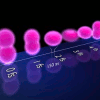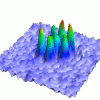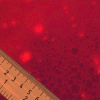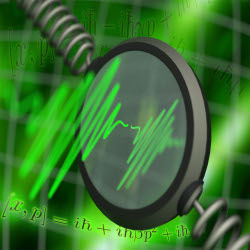-
Viewpoint on 'IONS'
Viewpoint on 'Scientific Literacy'
- Proudly sponsored by
-


-
Snapshots of Electrons in Motion

Recent, groundbreaking experiments have permitted the study of the motion of electrons in atoms right after ionization. This leads the way to a better understanding and control of the motion of electrons in atoms and molecules.
-
The Ultracold Laser Show

In nightclubs and live concerts, figures or text are often outlined by quickly steering one single laser beam. The same principle has now been applied to drawing potentials onto ultracold gases: a new technique that could soon make its way into laboratories.
-
Subnanometer Perfection

According to French philosopher Voltaire (1694-1778) the perfect is the enemy of the good, thus not exactly desirable. As recent results show, however, where scientific research is concerned this may not always hold true.
Volume 17 Story 6 - 9/8/2012

Modern physics stands largely on two distinct pillars — quantum physics and general relativity. Interestingly, these two theories are conceptually rather different and they sometimes even yield contradicting predictions. No wonder then, that scientists have been hard at work for decades, trying to reconcile these two theories into one new unified theory. While several proposals have been put forward, however, it has not yet, to date, been possible to conceive a feasible experimental test of their key predictions, and thus of their validity. This might now be about to change. A team of researchers led by Markus Aspelmeyer and Caslav Brukner from the University of Vienna, Austria, and by Myungshik S. Kim from Imperial College London, UK, has recently shown how an opto-mechanical experiment could finally shed light on how nature behaves at the intersection between general relativity and quantum physics. Their research brings previously inaccessible physics closer to experimental observation and has the potential to impact on the very foundations of modern physics.
Why would we want to unite quantum physics and general relativity, though? To answer this question, think about the following: what is the ultimate goal of physics? Of course, physicists systematically study the laws of nature: they create models of phenomena to predict the workings of nature and they compare these models to the outcomes of experiments. The ultimate goal of physics, however, lies far deeper: it lies in creating a coherent, fundamental understanding of the laws of nature. This aim has been driving the great minds of each century to develop new theoretical frameworks, mathematical tools, as well as new experimental techniques. Unifying quantum physics and general relativity, therefore, would tremendously advance our understanding of nature in many ways: conceptually, we would know how to better look at certain phenomena; technologically, we could probably exploit this improved understanding; and fundamentally, it would be great to learn how far the new theory could be applied and what it is that we still do not understand!
Classical physics as taught in high schools works very well for most everyday situations. Cars, jet engines, and the weather are all well described within its framework. However, classical physics starts to lose its accuracy when we come to consider more extreme situations: for example, when studying tiny particles such as the electrons of an atom, or the precise interaction between atoms and light. As a matter of fact, even the classical concepts begin to fall apart then: a classical particle can be thought of as a tiny billiard ball located somewhere in space; in contrast, many phenomena involving elementary particles simply cannot be described using these classical concepts. Therefore, we need a more adequate framework, like quantum physics. Other extreme situations are encountered in astronomy: objects moving at speeds comparable to the speed of light — approximately 300,000 km per second — or extremely heavy masses, such as the mass of our Sun, also turn out to be poorly described by classical physics. Here, general relativity proves to be the adequate framework because it introduces the concept of space-time, and shows how masses and speeds affect space and time. Such relativistic effects are, of course, totally unthinkable in classical physics, but they have been observed in countless experiments. In conclusion, we must include both quantum and relativistic effects in our physical models in order to gain a coherent understanding of nature.
To merge quantum physics and general relativity, we need to know how nature actually behaves. Unfortunately, however, it is extremely difficult to devise experiments that study situations for which these two theories yield different predictions. In fact, even the most advanced experiments currently available — from huge particle accelerators to space-based astronomical quantum-gravitational observatories — are still far from being able to access the required length or energy scales able to see differences between the prediction of general relativity and quantum physics
Instead of elusive lengths or energies, the researchers in London and Vienna focused on one of the cornerstones of quantum physics: the Heisenberg uncertainty principle. "The Heisenberg uncertainty principle," Kim explains, "says that position and momentum cannot be measured jointly with arbitrary precision." The momentum is related to the mass and speed of an object. "This implies," he continues, "that an extremely precise measurement of position would lead to tremendous fluctuations in the momentum. Such arbitrarily large fluctuations, however, are incompatible with general relativity. After all, the latter postulates the speed of light as the maximum speed. We, therefore, expect to observe relativistic corrections to the current Heisenberg uncertainty relations. And the experiment we propose could detect them."
So what does the experiment look like? "In the proposed experiment, we would be able to study the Heisenberg uncertainty of a tiny moving mirror using a laser beam," Kim says. "The beam would bounce off the mirror and by measuring its phase we would ultimately be able to determine whether or not there are any predicted quantum-gravitational effects." In fact, the team has discovered that it is possible to probe for these quantum-gravitational effects by bouncing the laser off the mirror four times.
"The theories being tested are very speculative," comments Howard Wiseman [1], Director of the Center for Quantum Dynamics at Griffith University, Australia. According to Wiseman, the proposed experiment is a great step towards expanding our understanding of nature. In particular, he is very excited about the fact that the proposed experiment is so much smaller and cheaper than other experiments that would hope to probe for the differences between quantum physics and general relativity. "We physicists," Wiseman concludes, "look forward to the (very rare) times when one of our most cherished theories is overthrown. That is because, based on past experience, we believe we will eventually find something to replace them that is even weirder and harder to understand, but at the same time even more compelling and far-reaching in its applicability and implications for our understanding of the universe and our place in it."
[1] Howard M. Wiseman & Gerard J. Milburn. Quantum Measurement and Control. Cambridge University Press. ISBN 978-0-521-80442-4

Towards Reconciling Einstein and Planck
Quantum physics and general relativity have completely changed our understanding of nature and kick-started the 20th century’s technological revolution — be that as it may, these two theories sometimes deliver contradictive results. A new proposal may finally be able to shed light on this issue.
How to challenge our current understanding of physics. Artistic illustration of a proposed experiment to probe quantum gravity: a laser pulse is used to measure the position of a mirror and look for possible quantum gravitational effects. Image: Jonas Schmöle, VCQ, University of Vienna.
Why would we want to unite quantum physics and general relativity, though? To answer this question, think about the following: what is the ultimate goal of physics? Of course, physicists systematically study the laws of nature: they create models of phenomena to predict the workings of nature and they compare these models to the outcomes of experiments. The ultimate goal of physics, however, lies far deeper: it lies in creating a coherent, fundamental understanding of the laws of nature. This aim has been driving the great minds of each century to develop new theoretical frameworks, mathematical tools, as well as new experimental techniques. Unifying quantum physics and general relativity, therefore, would tremendously advance our understanding of nature in many ways: conceptually, we would know how to better look at certain phenomena; technologically, we could probably exploit this improved understanding; and fundamentally, it would be great to learn how far the new theory could be applied and what it is that we still do not understand!
Classical physics as taught in high schools works very well for most everyday situations. Cars, jet engines, and the weather are all well described within its framework. However, classical physics starts to lose its accuracy when we come to consider more extreme situations: for example, when studying tiny particles such as the electrons of an atom, or the precise interaction between atoms and light. As a matter of fact, even the classical concepts begin to fall apart then: a classical particle can be thought of as a tiny billiard ball located somewhere in space; in contrast, many phenomena involving elementary particles simply cannot be described using these classical concepts. Therefore, we need a more adequate framework, like quantum physics. Other extreme situations are encountered in astronomy: objects moving at speeds comparable to the speed of light — approximately 300,000 km per second — or extremely heavy masses, such as the mass of our Sun, also turn out to be poorly described by classical physics. Here, general relativity proves to be the adequate framework because it introduces the concept of space-time, and shows how masses and speeds affect space and time. Such relativistic effects are, of course, totally unthinkable in classical physics, but they have been observed in countless experiments. In conclusion, we must include both quantum and relativistic effects in our physical models in order to gain a coherent understanding of nature.
To merge quantum physics and general relativity, we need to know how nature actually behaves. Unfortunately, however, it is extremely difficult to devise experiments that study situations for which these two theories yield different predictions. In fact, even the most advanced experiments currently available — from huge particle accelerators to space-based astronomical quantum-gravitational observatories — are still far from being able to access the required length or energy scales able to see differences between the prediction of general relativity and quantum physics
Instead of elusive lengths or energies, the researchers in London and Vienna focused on one of the cornerstones of quantum physics: the Heisenberg uncertainty principle. "The Heisenberg uncertainty principle," Kim explains, "says that position and momentum cannot be measured jointly with arbitrary precision." The momentum is related to the mass and speed of an object. "This implies," he continues, "that an extremely precise measurement of position would lead to tremendous fluctuations in the momentum. Such arbitrarily large fluctuations, however, are incompatible with general relativity. After all, the latter postulates the speed of light as the maximum speed. We, therefore, expect to observe relativistic corrections to the current Heisenberg uncertainty relations. And the experiment we propose could detect them."
So what does the experiment look like? "In the proposed experiment, we would be able to study the Heisenberg uncertainty of a tiny moving mirror using a laser beam," Kim says. "The beam would bounce off the mirror and by measuring its phase we would ultimately be able to determine whether or not there are any predicted quantum-gravitational effects." In fact, the team has discovered that it is possible to probe for these quantum-gravitational effects by bouncing the laser off the mirror four times.
"The theories being tested are very speculative," comments Howard Wiseman [1], Director of the Center for Quantum Dynamics at Griffith University, Australia. According to Wiseman, the proposed experiment is a great step towards expanding our understanding of nature. In particular, he is very excited about the fact that the proposed experiment is so much smaller and cheaper than other experiments that would hope to probe for the differences between quantum physics and general relativity. "We physicists," Wiseman concludes, "look forward to the (very rare) times when one of our most cherished theories is overthrown. That is because, based on past experience, we believe we will eventually find something to replace them that is even weirder and harder to understand, but at the same time even more compelling and far-reaching in its applicability and implications for our understanding of the universe and our place in it."
[1] Howard M. Wiseman & Gerard J. Milburn. Quantum Measurement and Control. Cambridge University Press. ISBN 978-0-521-80442-4
Armand Niederberger
2012 © Optics & Photonics Focus
AN is a Research Associate with the Department of Applied Physics at Stanford University, California, USA. His research focuses on quantum circuits, modeling of nano-photonic devices, and numerical optimization.

Igor Pikovski, Michael R. Vanner, Markus Aspelmeyer, M. S. Kim & Caslav Brukner, Probing Planck-scale physics with quantum optics, Nature Physics (2012) 8, 393-397 (link).